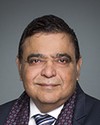Mr. Chairman and members of the committee, good afternoon.
I'm grateful to you for giving me the opportunity to express my concerns on recent events in Sri Lanka. I intend to clarify some of the misconceptions about this ethnic crisis, this terrible war between a legitimately elected, democratic government, a member of the Commonwealth, and a non-elected group, the Tamil terrorists, the Liberation Tigers of Tamil Eelam, also known as the Tamil Tigers.
Since 1983 the Tamil Tigers have been creating mayhem for Sri Lanka. For the past three decades this tiny island has been in crisis, hemorrhaging its people, its resources, and its soul. Only now, when the Tamil Tigers are about to be eliminated, only now after 26 years are some countries, including Canada, taking an interest in this terrorist war.
Such interest prompted Canada to have an emergency debate on Sri Lanka in Parliament on February 4. Watching the debate on CPAC, I found it an amazing piece of theatre. It was mostly Sri Lanka government bashing and not the bashing of the Tamil Tigers, who are indeed a killer cult. There were moments of hoax theatre when five Liberal members of Parliament accused the Sri Lankan government of genocide. No doubt those members have found out since then that the charge was unfair, unwholesome, and incorrect.
The Tamil Tigers, the LTTE, have been banned as a terrorist organization in 32 countries, including Canada. They have assassinated two heads of state--Prime Minister Rajiv Gandhi of India, and President Ranasinghe Premadasa of Sri Lanka--and 32 other politicians in Sri Lanka, including three mayors of Jaffna and the country’s foreign minister, all Tamils. Of the 32 assassinated politicians, 18 were moderate Tamils.
The LTTE are the terrorists who perfected the body pack for the human bomb and exploded the 379th human bomb in Mullaitivu, a few metres from an army front line on March 17. On January 11, 2008, the FBI described the LTTE as the most dangerous and deadly extremist outfit in the world. The FBI has credited them with perfecting the use of suicide bombers, inventing suicide belts, and pioneering the use of women in suicide attacks. The FBI says that this rebel group's ruthless tactics have inspired terrorist networks worldwide, including al-Qaeda in Iraq.
The Tamil Tiger terrorist group, now proscribed in Canada and for over a quarter century an existential threat to the integrity of Sri Lanka’s democracy, is now on the ropes. Eighteen months back they controlled an area of Sri Lanka that exceeded 15,000 square kilometres. They have now been pushed back by Sri Lankan armed forces to a sliver of land about 25 square kilometres, an area less than what we can see from Parliament Hill here in Ottawa.
A long intransigent, uncompromising group, the Tamil Tigers are now groveling and begging for a ceasefire. The long-suffering people of Sri Lanka have seen this all before. Six times the Government of Sri Lanka, yearning for peace, agreed to ceasefires. Six times the Tigers reneged. No government wants to go back to the ruinous business of war. But during each of those six ceasefires, the Tamil Tigers rearmed themselves and recruited sufficient cadres to continue, including, I must add, children under the age of 14--in fact, 6,300 of them, according to UNICEF.
There was no stopping these ruthless aggressors. The years 1985, 1987, 1989, 1995, 2000, and 2002 all saw ceasefires. The Tamil Tigers--and I emphasize it was the Tamil Tigers--always resumed war.
The last ceasefire, negotiated by Norway, between February 2002 and January 2008, is a classic case in point. It lasted longer than the others. According to the Scandinavian ceasefire monitors, by July 14, 2006, the Tamil Tigers had violated the ceasefire 7,308 times. During the same period, the Sri Lankan armed forces had violated the ceasefire just under 200 times. So it's no wonder the Tamil Tigers agreed to that sweetheart deal worked out in Oslo.
During the last ceasefire, the Tamil Tigers brought in 11 shiploads of arms. The 12th shipload got away when the Norwegian head of the Scandinavian ceasefire monitors, General Trygve Tellefsen, tipped the captain of the ship that the Sri Lankan navy was after them. This ceasefire saw the Tamil Tigers bring in four Czech Zlin 143 propeller aircraft, which were turned into night bombers. They graduated to become the first international terrorist outfit to have an air wing.
It was during this ceasefire that the Tamil Tigers built seven airstrips, two of which were long and wide enough to land large cargo transport planes.
The internationally respected journal on military intelligence, Jane's Intelligence Review, says these transport planes were very likely to have flown in arms. It was during this ceasefire in 2002 that the Norwegians helped the LTTE to build strong high-tech communication systems by bringing in six tons of electronic equipment as diplomatic cargo, including V satellite equipment for satellite communications. It was during this ceasefire that the Tamil Tigers started manufacturing submarines and suicide craft. Ladies and gentlemen, it was during this ceasefire that the Tamil Tigers developed their vast Tamil Tiger criminal enterprise—credit card fraud, shakedowns, heroin, human smuggling—raking in hundreds of millions of dollars, much of it from Canada.
Everything the Tamil Tigers did during that ceasefire was to further a military victory over Sri Lanka. Certainly, Sri Lanka also built up its armed forces. Would Canada not do so if it were under such constant threat? Sure enough, as soon as the Tamil Tigers felt they had the capability of defeating Sri Lanka’s army, their leader, Prabhakaran, restarted the war. It was interesting to see Tamil Tiger attitudes change over the course of the ceasefire. At first they feigned interest in a negotiated settlement. During the last session in Geneva, members of the delegation, given visas by the Swiss and Norwegians, spent all their time raising funds amongst the Tamil diaspora. They did not even bother turning up at the negotiating table, which embarrassed the Norwegians who had facilitated that meeting.
I'm going to skip some of my presentation because the time is running out.
Surrounded closely on all sides by 50,000 soldiers and sailors, what is this megalomaniac Prabhakaran up to? In the narrow strip of land he controls, there are about 500 hard-core cadres, maybe a thousand children and old persons he has forcibly conscripted into carrying armaments, and approximately 50,000 Tamil civilians who have been taken hostage. There is clear evidence that the Tamil Tigers have built bunkers and sited their remaining long guns right in the middle of the hapless human shields. The Sri Lankan government has declared a large swath of seaside land a safe zone and is doing its best to protect this civilian population. Indeed, destroying the Tamil Tigers could happen in a single day because the core is no further from army positions than we are from Aylmer, Quebec.
I bristle, and Sri Lankans bristle, when foreigners declare their sympathies for these poor Sri Lankan hostages. Make no mistake--Sri Lankans care about them more than you do, more than anyone does. It is, therefore, with astonishment that I observe Sri Lankan Tamil Canadian demonstrators saying absolutely nothing about the Tamil Tigers releasing their human shields. The constant theme is “ceasefire”, you may have noticed. And, of course, one of our Liberal MPs spoke at such a demonstration on March 5, saying “I'd like to let you know I’m helping you guys. I’m behind you because you are fighting a right cause.” He of course conveniently forgot that it was some of his clan extremists who brought down Air India Flight 182, killing 312 Indo-Canadians on June 23, 1985, the worst terrorist attack in Canadian history.
Of course, as I explained to you in the beginning, the entire thrust of the recent Tamil Tiger propaganda campaign has been to save the leadership; save these nasties to fight another day; to blow up ten thousand more civilians; to assassinate moderate Tamil leaders; to kill democratically elected leaders; and to further destroy my beautiful motherland. No, it will not happen. And if I have my way, I will never let it happen.
You might ask whether I believe that peace is possible in Sri Lanka. My answer is an emphatic yes. The eastern province is a case in point, which had democratic elections for its provincial council seven months after the Tamil Tigers were wiped out. Its people elected a former Tamil Tiger child soldier, Piliyan, who gave up terrorism in 2004, as their chief minister. The development of the eastern province is going full speed ahead, and the people are content. This certainly will happen in the northern province too, once the Tamil Tiger curse is eliminated.
So the answer is, I repeat, yes, peace is possible in Sri Lanka.
Mr. Chairman, I've cut my statement as much as I can. Ladies and gentlemen, permit me to thank you once again for giving me the opportunity to address you all.





